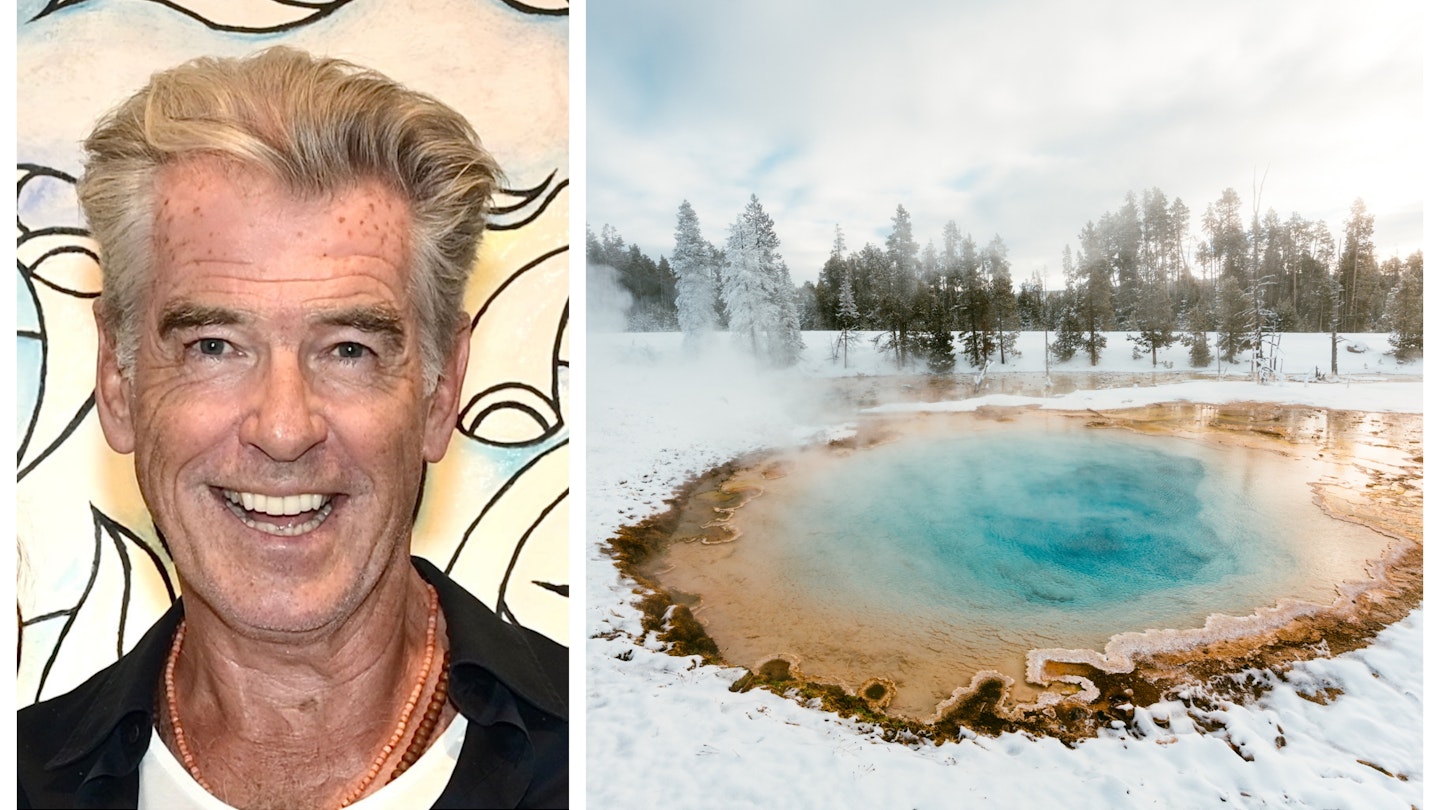Exploring Yellowstone’s Geothermal Features Safely
Wander around Yellowstone National Park’s geothermal features, and you’ll notice the fire-engine-red warning signs just as prominently as the bison. “Dangerous Ground,” reads one, translated into five languages. The sign warns visitors to remain on designated paths while admiring the park’s bubbling beauties, reinforced with an image of a hiker veering off the trail, alarmed by a steaming vent beneath their feet.
Despite warnings that park rangers have put in place since at least 1888, daring visitors continue to disobey park regulations, risking exposure to deadly dangers as well as potential criminal charges.
Celebrity Warnings: Pierce Brosnan’s Incident
Recently, the famous actor Pierce Brosnan, best known for his role as James Bond, found himself in trouble in Yellowstone. According to federal citations, he wandered into an off-limits area at Mammoth Terraces, an area known for its remarkable travertine formations fed by around 50 boiling springs. He is scheduled for a court appearance on January 23, where he will face consequences for his actions. Notably, violations of park rules can result in significant fines and even jail time.
While repercussions may seem harsh, visitors should always adhere to Yellowstone’s rules and reconsider any temptation to dip a toe into a hot spring or approach a geyser too closely. Here’s how to fully enjoy the park’s hydrothermal wonders while keeping safety in mind.
Understanding the Source of Heat in Yellowstone
Yellowstone lies atop a supervolcano, creating an underground furnace that causes over 10,000 thermal features to gurgle, spit, and steam. The results can be mesmerizing, like the colorful bands of liquid within the Grand Prismatic Spring, whose eye-catching pools appear inviting.
For centuries, people have appreciated thermal waters for their beauty and potential benefits. Before European colonizers arrived, indigenous peoples used naturally-heated pools for ceremonial and medicinal purposes. Fast forward to the present, travelers plot entire vacations around geothermal spas from Germany to Japan.
The Dangers of Soaking in Yellowstone
Despite the alluring appearance of Yellowstone’s thermal features, the waters are not safe for soaking. Approaching hissing fumaroles or capturing photos of painterly mud pots poses serious risks. According to the National Park Service (NPS), “Water in hot springs can cause severe or fatal burns, and scalding water underlies most of the thin, breakable crust surrounding these springs.” Additionally, paths near these heat spots change unpredictably, complicating the determination of safe routes.
Even seemingly calm water features can reach scorching temperatures, often exceeding 200°F (93°C), which are unsuitable for swimming.
Historical Fatalities Related to Hot Springs
Since the park’s establishment in 1872, 22 people have tragically perished due to the extreme temperatures and acidic conditions of hot springs—surpassing the number of fatalities from bear and bison encounters, as noted by the US Geological Survey.
In 2016, the body of a young man was “dissolved” after falling into an acidic pool in a prohibited area. More recently, another individual went missing after entering a hot spring pool in 2022. These incidents underscore the serious risks associated with disregarding park regulations.
How to Enjoy Yellowstone’s Geothermal Features Safely
Consider the geothermal features of Yellowstone as part of the park’s broader ecosystem, akin to its diverse wildlife. Admiring these wonders from a safe distance is paramount. The park maintains excellent boardwalks and trails that offer breathtaking views of the most stunning geothermal sights. Visitors are encouraged to stay on established paths, similar to how they would treat sightings of wildlife.
Moreover, the NPS advises visitors against touching pools or their runoff, even when they appear more inviting than tropical waters. It is also critical not to throw objects into hot springs and to avoid chasing anything inadvertently dropped into them.
If you’re seeking a safe swimming experience in Yellowstone, consider the Firehole Swim Area, a section of the Firehole River warmed by an upstream geothermal feature, making it suitable for swimming. Other lakes in the park tend to be too cold, posing a risk of hypothermia.
The Global Appeal of Hot Springs
It’s essential to note that Yellowstone is not the only location renowned for its captivating yet dangerous hot springs. Various regions worldwide feature similar wonders. For instance, New Zealand offers the Champagne Pool, which, despite its inviting name, can reach a blistering 165°F (74°C), posing severe risks. While soaking in hot springs can be refreshing, safety guidelines must always be meticulously followed.
For those interested in experiencing the rejuvenating effects of geothermal soaking, consider visiting Tuscany’s Cascate del Mulino, where the thermal stream rests at a balmy 99°F (37°C). Alternatively, therapeutic waters are available at Turkey’s Pamukkale, famously linked to Cleopatra’s legendary bathing habits.
Within the United States, options abound, including hot springs in Calistoga, California, and the picturesque mountains of Colorado. For those focusing on Wyoming, Hot Spring State Park offers a chance to unwind at the Wyoming State Bath House.
When it comes to geothermal swimming on a grand scale, few locations rival Iceland. Just like Yellowstone, this island nation is home to numerous hydrothermal features inspired by volcanic activity. Unlike Yellowstone, however, soaking in naturally-heated pools is a big part of Icelandic culture, allowing visitors to enjoy experiences reminiscent of those found in Yellowstone.
Exploring geothermal wonders can be an enthralling experience, provided safety takes precedence. Planning carefully will ensure an enjoyable adventure and the opportunity to appreciate the beauty of nature safely.





